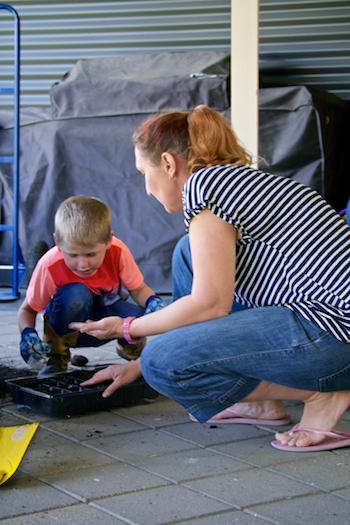Planting a seed
Duration/age

Before planting the seed read the instructions on the packet with your child. As you read the instructions point out the different symbols that are used to give direction to know where to plant the seed, how deep to plant it and how big it will grow. Talk to your child about what size container you will need for the seed to grow in.
If the seed grows into a tall plant the roots will grow down deep and will need a tall container. If the seed grows into a spreading plant that is wide the container will need to be shallow and wide.
How much sun will the plant need - full sun or shade?
Is it a plant that will require watering every day or a drought tolerant plant that only needs to be watered weekly? How soon will you see the first leaves of the plant pop above the ground and how long after that before it flowers or fruits?
Materials you will need
- Seedlings
- Pots
- Garden stakes
- Spade
- Gloves
- Potting mix
Alternative tools
- Ice-cream container
- Seedlings
- Spoon
- Egg carton
Skills this activity improves
Why does this matter?
Growing and planting helps children to learn that we can describe and compare objects by size, capacity and volume. Reading the packet helps children to understand that we can use symbols to describe words and concepts.
What does this lead to?
Exploring the different terms and attributes we use to describe objects such as width, depth, or heat helps children understand that we can measure objects in different ways and that the tool we use to measure this will be different depending on what we are measuring. Children will develop an understanding that symbols are a tool to help quantify our world and that this is an attribute of number. As children explore numbers they begin to understand that number can be written as a word, as a numeral or as symbols.
Language to use
- Deep, shallow, narrow, tall, wide
- Metre, centimetre
- Full sun, partial sun, full shade, partial shade
- Weeks, days, daily, weekly, monthly
Questions to use
- How long will the plant take to grow?
- Where is the sunniest part of the garden?
- Is there a part of the garden that has both sun and shade?
- How many seeds do we have to plant?
- How many containers do we need for the seeds?
Useful tips
- Your child might enjoy having their own gloves.
- Remember to talk to your child in your home language.
More ideas
- Make signs for the seeds to identify what is growing in the pot.
- Create a calendar for watering and predict when the plant will appear above the ground.
- Talk about the volume of water the plant / seed will need and what size watering can will hold that much.
Variation by age
Birth to two year olds
- Set up a watering trough with different sized containers for pouring and measuring.
- Sing songs and read about growing.
- Put a carrot top on cotton wool and watch it grow.
- Make wheat seed caterpillars using egg cartons.
Three to five year olds
- Create a measuring stick to measure and record the growth of the plant.
- Make rain gauges around the garden to collect and record the rain as it falls.
- Look up what plants to plant together as ’companion plants’ to prevent bugs from eating the plants.
- Go to the library and borrow stories and books on growing.
- If you planted vegetables look for recipes of things you can cook using the vegetables.
Questions to ask
- How much?
- How many?
- How big?
- How long?
- How much will it hold?
Questions to ask
- What is a companion plant?
- Which plants go together?
- Which vegetables will grow above the ground and which vegetables will grow under the ground?
- Can we eat any of the vegetables raw?
- If we change the shape of the container in the rain gauge will we collect more or less rain?


